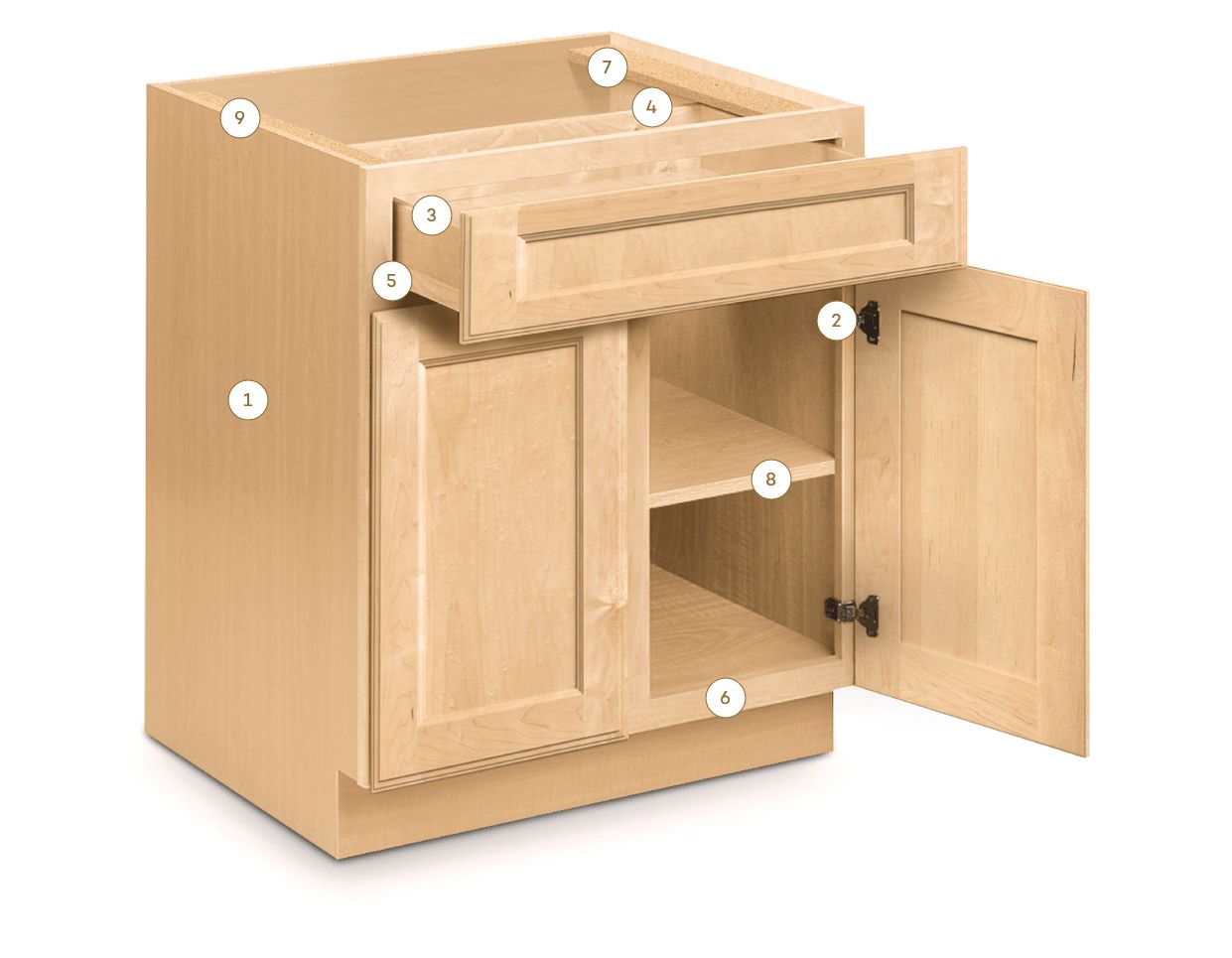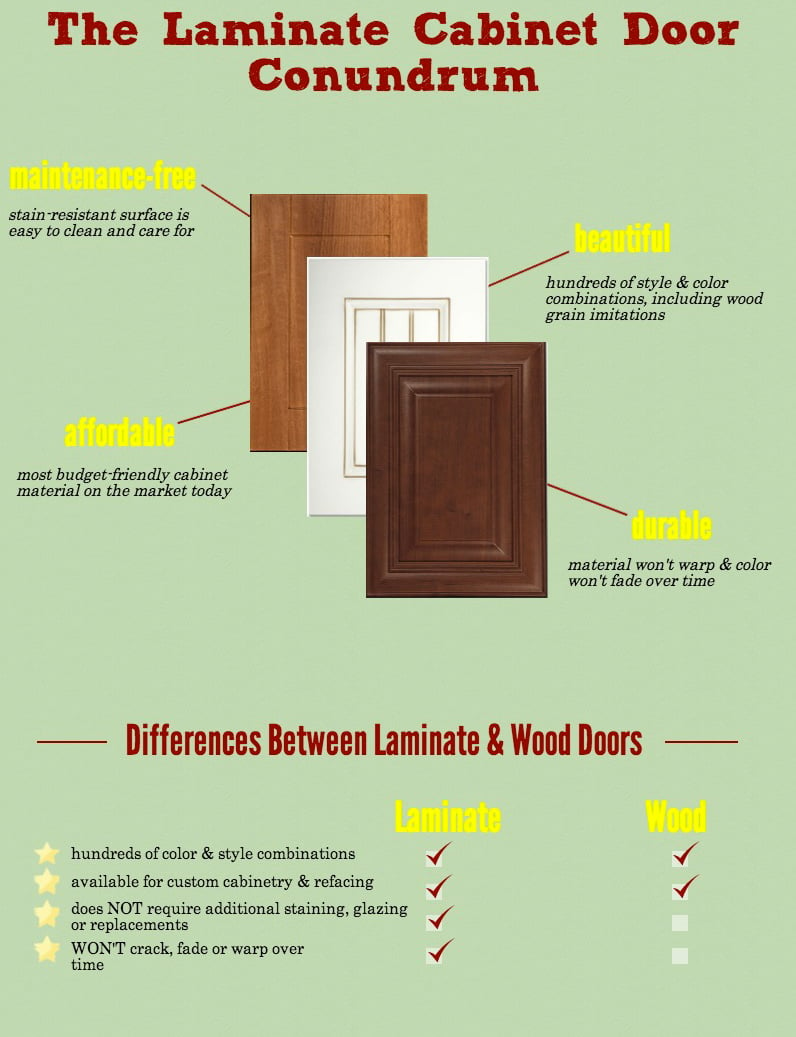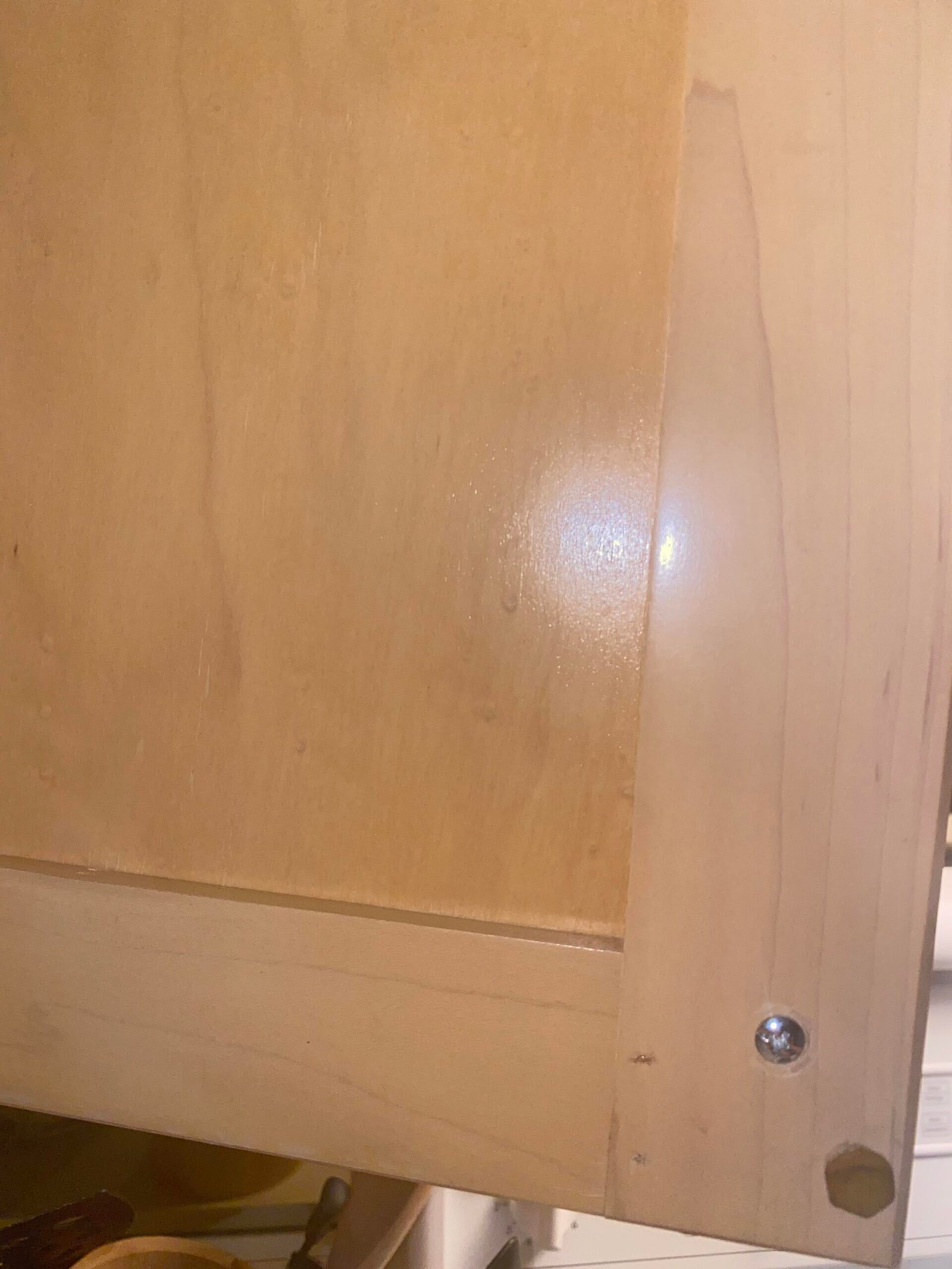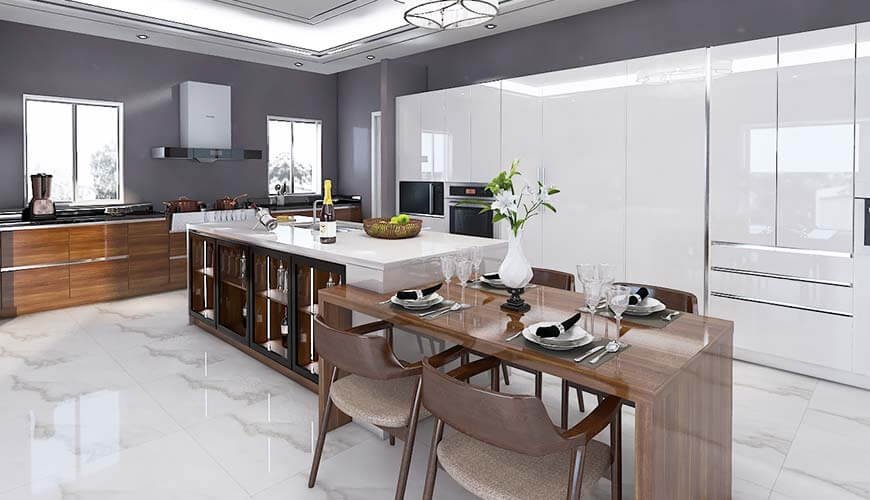To tell if kitchen cabinets are real wood, check the grain pattern and look for joints or seams. Real wood has natural variations and distinct grain lines.
Identifying real wood kitchen cabinets can enhance the aesthetics and longevity of your kitchen. Real wood cabinets are durable, long-lasting, and can be refinished. They add a touch of elegance and warmth to your home. Knowing the difference between real wood and engineered materials helps you make informed decisions.
Look for natural imperfections in the wood, such as knots or color variations. Inspect the edges and corners for dovetail joints, a sign of quality craftsmanship. Real wood cabinets also emit a unique, natural smell. These features ensure that you are investing in a product that offers beauty and durability.
Table of Contents
ToggleIdentifying Real Wood Cabinets
Determining if your kitchen cabinets are made of real wood can be tricky. Real wood cabinets bring warmth and natural beauty to your kitchen. To ensure your cabinets are genuine wood, look closely at specific features.
Grain Patterns
Real wood cabinets have unique grain patterns. Each piece of wood has its own grain pattern, making it unique. Look for irregularities in the grain patterns. If the patterns repeat, the wood might be fake. Real wood shows natural, non-repeating patterns.
| Real Wood | Fake Wood |
|---|---|
| Unique, irregular grain patterns | Repeating, uniform patterns |
| Natural variation in color and texture | Consistent color and texture |
Another way to check the grain is by touching the surface. Real wood has a natural feel with small imperfections. Fake wood feels smoother and more uniform.
Wood Knots
Wood knots are another sign of real wood cabinets. Knots are small, round, or oval imperfections in the wood. They occur where branches once grew out of the tree trunk. Real wood cabinets will have these natural marks.
- Real wood cabinets have visible knots.
- Fake wood cabinets often lack these features.
Knots add character and uniqueness to your cabinets. If you see knots, your cabinets are likely made from real wood. Fake wood often mimics the look of knots but lacks the depth and texture of real wood.
By examining grain patterns and wood knots, you can tell if your kitchen cabinets are real wood. Real wood cabinets enhance the beauty and value of your kitchen. Look carefully at these features to ensure authenticity.

Material Comparison
Choosing kitchen cabinets involves understanding the material. Knowing whether your cabinets are real wood helps in making an informed decision. This section compares different materials to help you identify real wood cabinets.
Solid Wood Vs. Plywood
Solid wood is entirely natural and cut from a single piece of timber. It has natural grain patterns, which are unique and easily identifiable.
Plywood consists of multiple layers of wood veneers glued together. These layers create a strong, stable material, but the edges reveal its layered construction.
| Feature | Solid Wood | Plywood |
|---|---|---|
| Material Source | Single piece of timber | Multiple wood veneers |
| Appearance | Natural grain patterns | Layered edges |
| Durability | High | Moderate |
Real Wood Vs. Veneer
Real wood cabinets are made from solid wood or plywood. They are more durable and can be refinished if needed.
Veneer cabinets have a thin layer of real wood or synthetic material. This layer is bonded to a less expensive substrate like particleboard or MDF.
- Real wood can be sanded and refinished.
- Veneer can’t be sanded as it may damage the thin layer.
To identify real wood, check for natural grain patterns. Look at the edges to see if they are solid or layered.
Inspecting Cabinet Interiors
To determine if your kitchen cabinets are made of real wood, you should inspect the interiors. Real wood cabinets have distinct features inside that can help you confirm their authenticity. Let’s look at the back panels and shelving to identify real wood.
Back Panels
The back panels of cabinets can reveal a lot about their material. Real wood back panels usually have a consistent grain pattern. You may also see knots and natural imperfections, which are signs of real wood.
- Consistent Grain Pattern: Look for uniform wood grains.
- Knots and Imperfections: Check for natural wood flaws.
Fake wood often has uniform, repeating patterns. These patterns lack the unique characteristics of real wood.
Shelving
Shelves in real wood cabinets are often sturdy and have a natural finish. You should also check the edges of the shelves.
- Sturdiness: Real wood shelves feel solid and heavy.
- Natural Finish: Look for a natural, unpainted finish.
- Edge Grain: The grain on the edges should match the surface.
Fake wood shelves may feel lighter and have a plastic-like coating. These shelves often lack the natural grain and imperfections of real wood.

Analyzing Joints And Edges
Identifying if kitchen cabinets are made of real wood can be tricky. Analyzing the joints and edges can provide valuable clues. Properly constructed real wood cabinets often showcase specific joint types and edge finishes.
Dovetail Joints
Dovetail joints are a strong sign of real wood. These joints interlock like puzzle pieces. They are usually found in drawer corners. Dovetail joints are strong and durable. They are difficult to make using particleboard or MDF. Check the inside of drawers for these joints. You will often see a series of triangular shapes fitting together.
| Material | Type of Joint | Durability |
|---|---|---|
| Real Wood | Dovetail Joints | High |
| Particleboard | Butt Joints | Low |
Edge Banding
Edge banding is a method to cover the exposed edges of materials. Real wood cabinets usually have solid wood edges. These edges are smooth and polished. They match the rest of the cabinet. If the edges have a plastic or vinyl strip, it’s likely not real wood. Real wood edges may show the wood grain pattern. This pattern is unique and cannot be replicated by synthetic materials.
- Real Wood: Smooth, polished edges matching the cabinet.
- Particleboard: Edges covered with plastic or vinyl strips.
By carefully analyzing the joints and edges, you can determine if your kitchen cabinets are real wood. Look for dovetail joints and solid wood edges. These features are key indicators of genuine wood construction.
Surface And Finish Examination
Examining the surface and finish of your kitchen cabinets can help you determine if they are made of real wood. This process involves closely inspecting the staining and paint. Real wood often reveals unique features that manufactured materials lack.
Staining
Real wood usually has a distinct grain pattern. These patterns are unique and never repeat. To identify real wood, look for natural imperfections and variations in the grain. If the grain pattern looks too uniform, it might be a veneer or laminate.
Stains on real wood penetrate deeply and highlight the wood’s natural beauty. Lightly scratch the surface in an inconspicuous area. If the color varies, it is likely real wood. If the scratch reveals a different color underneath, it might be a veneer.
| Characteristic | Real Wood | Veneer/Laminate |
|---|---|---|
| Grain Pattern | Unique and varied | Uniform and repeating |
| Surface Imperfections | Natural imperfections | Minimal to none |
| Scratch Test | Color varies with depth | Different color underneath |
Paint
Paint can sometimes hide the true nature of the material. Check for wear and tear at the edges and corners. Real wood often shows signs of wear that reveal the natural wood underneath. Painted surfaces on real wood may also show grain texture.
Tap on the surface with your knuckle. Real wood produces a solid, deep sound. Laminate or veneer has a hollow sound. Peeling paint can also be an indicator. If the paint peels and reveals wood, it’s real. If it reveals a different material, it’s likely not real wood.
- Check edges and corners for wear.
- Look for grain texture under paint.
- Tap the surface to check the sound.
- Inspect for peeling paint.
Weight And Density
Determining if kitchen cabinets are real wood can be tricky. One effective method is to check their weight and density. Real wood cabinets have specific heft and density variations. Understanding these can help you identify genuine wood cabinets.
Heft
Real wood cabinets feel heavier than synthetic ones. Lift a cabinet door or drawer to test. Genuine wood should have a solid, substantial feel. This heft is due to the natural properties of wood. Synthetic materials like MDF or particleboard feel lighter.
Density Variations
Natural wood has varied density. Different wood types have different densities. Oak, for example, is denser than pine. Check for these variations to identify real wood. Observe the grain patterns and textures. Real wood displays unique, irregular patterns. Synthetic materials have uniform, repetitive patterns.
| Wood Type | Density (lbs/ft³) | Characteristics |
|---|---|---|
| Oak | 47-56 | Heavy, strong, prominent grain |
| Pine | 22-35 | Lighter, softer, straight grain |
| Maple | 39-47 | Hard, durable, fine grain |
Use your hands to feel the surface. Real wood often has natural imperfections. Synthetic materials are smooth and uniform. Look for subtle differences in texture and weight.
- Heft: Lift to feel the weight.
- Density Variations: Check for unique patterns and textures.
These steps can help you determine if cabinets are real wood. Feel the weight and observe the density variations. Genuine wood will always stand out with its natural properties.
Sound Test Techniques
Determining if your kitchen cabinets are made from real wood can be tricky. One effective way is through sound test techniques. These methods involve simple actions like knocking and listening to the echo. These can reveal a lot about the material of your cabinets.
Knocking
Knocking on the cabinet’s surface can help you identify if it’s real wood. Real wood produces a deep, solid sound. This sound indicates density and quality. On the other hand, particleboard or laminate will have a hollow, less satisfying knock. This difference is usually noticeable even to the untrained ear. Try knocking on different parts of the cabinet. Compare the sounds to get a clearer idea of the material.
Echo
Listening to the echo after knocking can also provide clues. Real wood absorbs sound better. This results in a muffled, short echo. Man-made materials like MDF or particleboard reflect sound more. This creates a longer, more pronounced echo. Stand close to the cabinet and knock gently. Pay attention to the sound that follows. A quick, dull echo suggests real wood. A lingering, sharp echo may indicate a synthetic material.

Expert Tips And Tools
Identifying whether kitchen cabinets are made of real wood can be challenging. Using expert tips and tools can simplify this process. Below are some professional methods that ensure accuracy.
Moisture Meters
Moisture meters are essential tools in determining wood authenticity. Real wood has specific moisture levels that differ from composites.
- Accurate Readings: Measure the moisture content of the cabinets.
- Easy to Use: Place the meter’s pins into the wood.
- Consistency: Real wood shows consistent moisture levels across the surface.
Invest in a high-quality moisture meter for precise readings. This tool can help spot fake wood materials quickly.
Professional Appraisal
Engaging a professional appraiser can ensure accurate identification of wood cabinets. Experts have the experience to distinguish between real and fake wood.
- Visual Inspection: Experts can identify wood grain patterns.
- Material Analysis: They check for natural wood characteristics.
- Valuation: Professionals provide an accurate value for the cabinets.
Hiring a professional appraiser may cost a fee. Yet, it guarantees the authenticity of your kitchen cabinets.
Frequently Asked Questions
How Can I Identify Real Wood Cabinets?
Check for grain patterns, weight, and wood joints. Real wood has unique grains and is heavier.
What Are The Signs Of Fake Wood Cabinets?
Look for uniform patterns, lighter weight, and visible laminates. Fake wood often lacks natural imperfections.
Are Real Wood Cabinets Heavier?
Yes, real wood cabinets are generally heavier compared to particleboard or MDF cabinets.
Do Real Wood Cabinets Have Visible Grain?
Yes, real wood cabinets exhibit natural and unique grain patterns, unlike synthetic materials.
Can I See Joints In Real Wood Cabinets?
Yes, real wood cabinets often use dovetail or mortise-and-tenon joints, indicating higher craftsmanship.
Is There A Smell To Real Wood Cabinets?
Yes, real wood cabinets have a distinct, natural woody aroma unlike synthetic materials.
Do Real Wood Cabinets Dent Easily?
Yes, real wood can dent or scratch more easily compared to laminate or MDF cabinets.
Are Real Wood Cabinets More Expensive?
Yes, real wood cabinets typically cost more due to the quality of materials and craftsmanship.
Can I Refinish Real Wood Cabinets?
Yes, real wood cabinets can be sanded and refinished multiple times, unlike laminate or veneer.
Do Real Wood Cabinets Change Color Over Time?
Yes, real wood can change color with exposure to sunlight and air, developing a rich patina.
Conclusion
Authenticating real wood kitchen cabinets can be straightforward with the right knowledge. Inspect the grain pattern, look for dovetail joints, and check for weight and consistency. By using these tips, you’ll ensure your kitchen cabinets are genuine wood, adding lasting value and beauty to your home.
Happy renovating!


